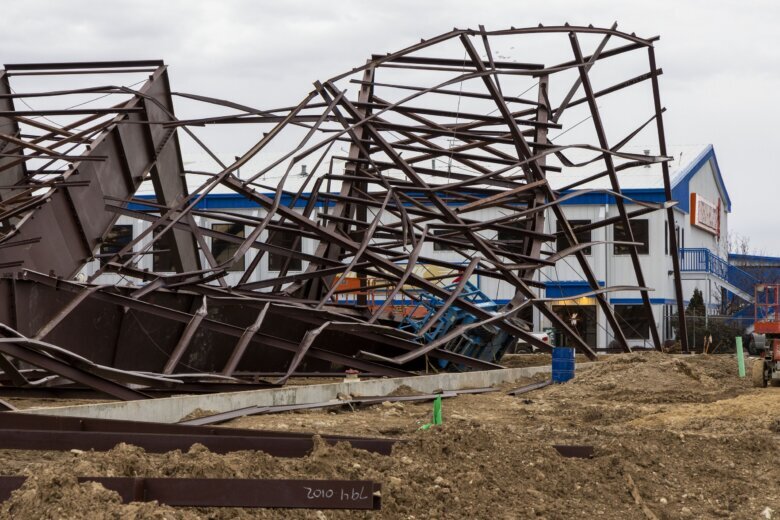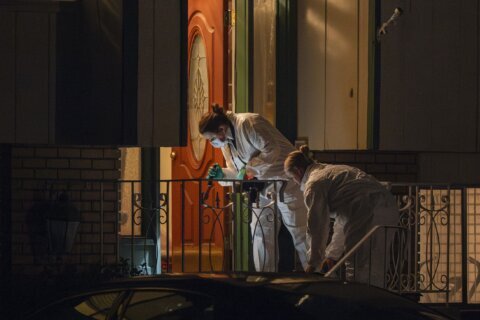
BOISE, Idaho (AP) — Federal investigators were working Thursday to try to determine what caused a steel airplane hangar that was under construction in Idaho to collapse the previous evening, killing three people and leaving several others badly injured.
The Boise Fire Department said in the morning that the scene was turned over to OSHA investigators. Though the hangar is at the Boise Airport, it is privately owned by Jackson Jet Center, a charter flight and maintenance company.
The Ada County Coroner’s office was expected to release the names of those killed once family members had been notified.
Nine other people were hurt, including five who had critical injuries and were hospitalized. Officials with Saint Alphonsus Regional Medical Center said they could not issue an update on the condition of the patients because of privacy laws.
The collapse was reported about 5 p.m., and first responders had to stabilize the massive structure while trying to rescue those who were trapped inside and underneath it. Steel girders and panels were bent, and a large crane was folded in the wreckage.
Inland Crane was hired to provide crane services for the hangar, but that work was largely completed when the accident occured, Jeremy Haener, company vice president, said in a statement. Haener said none of Inland Crane’s employees were injured but the company was mourning the loss of partners and friends.
“Based on accounts of Inland Crane operators, construction workers on site, and the steel erecting contractor, we believe that no action by Inland Crane operators or the crane itself were cause for the structural failure,” Haener said.
At the time of the accident, the crane was being used to place an end truss, Haener said.
“When the building collapsed due to an unknown structural failure, the crane boom — the hydraulic arm of the equipment — snapped on impact.”
Fire Department Operations Chief Aaron Hummel said some of the victims were on a hoist or other elevated platform when the structure fell, and that required specialized rescue efforts.
Boise Fire Chief Mark Niemeyer said Thursday that it had been a “tragic day” for the community and expressed “heartfelt condolences” to those affected. He also praised first responders “for their quick and professional response rescuing victims and caring for patients in a chaotic and very dangerous environment.”
Construction work can be hazardous, and steel erection — the type of work being done at the hangar — is one of the top 10 most dangerous occupations, according to data from the U.S. Bureau of Labor Statistics.
The construction industry had the highest number of fatal work injuries in 2002, the most recent year for which data is available, according to the bureau. The agency tallied 1,056 work-related deaths for the sector that year, the equivalent of 13 out of every 100,000 full-time workers.
Boise city records show that the Meridian-based contractor Big D Builders obtained permits to build a 39,000-square-foot (3,623-square-meter) hangar for Jackson Jet Center.
The $8.1 million project was to include earth grading, a concrete foundation and a metal building. Phone and email messages seeking comment from Big D Builders were not immediately returned.
Hummel said the building’s rigid steel frame had been erected and crews were still working on the structural components that would have tied it together when the “catastrophic” failure happened.
“It was a pretty global collapse that occurred, and the main structural members came down,” Hummel said.
Officials with the Occupational Safety and Health Administration have not yet released any details about possible causes. The investigation could take up to six months, according to David Kearns, area director for the Boise OSHA office.
“This is a tragedy with a lot of people across the valley grieving today,” Kearns said. “Unfortunately events like these often drive home the importance of ensuring that work site safety and health is a core value at workplaces.”
Wind can sometimes be a factor in the failure of buildings that are under construction, and gusts of up to 20 mph (32 kph) were recorded at the airport just before the collapse was reported, according to the National Weather Service in Boise.
Many other elements can also come into play, including the quality of welding and bolts, a structure’s design or how it is assembled and braced.
Kearns said he couldn’t talk about whether wind or other factors might have played a role.
OSHA records show that Big D Builders received multiple safety violations from the agency in the last 10 years. The first, in 2014, was for having workers who weren’t trained in the proper procedures for erecting extension ladders. Two others in 2017 and 2022 resulted from having subcontractor employees working too close to holes in floors or walls without adequate protection from falls. A fourth violation in 2023 resulted in a $21,875 fine — a higher amount because it was deemed a “repeat violation” — after OSHA said workers were exposed to fall hazards while installing metal sheathing on the roof of a steel building.
There was no indication in the OSHA records that anyone was ever injured in connection with those violations. Fall and ladder hazards are among the most common violations issued by the agency.
Big D Builders has operated in Idaho for 28 years, according to the Idaho Secretary of State’s website. It has worked on many steel fabricated construction projects throughout the West, including the SkyWest hangar at the Boise Airport, according to the company’s website.
Greg Baisch, who hired Big D Builders to construct his Sage Hills Equestrian facility last year in Eagle, said he was impressed with the company’s work and was shocked to hear of the hangar collapse.
“They were safe, conscientious, professional and did a fantastic job erecting the structure during the challenging winter season,” Baisch said. “I’d hire them again”
Jackson Jet Center officials said in a statement that they did not know what caused the collapse and “our focus now is on supporting our team and partners during this difficult time.”
Cody McGowan was working about 100 yards (90 meters) away Wednesday when he heard a sound like a loud dog whine. Looking up he saw the structure, perhaps 3½ to 4 stories high, collapsing on itself and part of the crane on top.
“It’s shocking to see a building falling in on itself,” McGowan said.
Copyright © 2024 The Associated Press. All rights reserved. This material may not be published, broadcast, written or redistributed.








